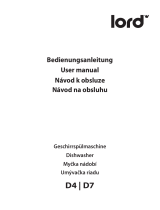
EN 10
Preparing and loading dishes
• Consider buying utensils which are identified as dishwasher-proof.
• For particular items, select a program with the lowest possible temperature.
• To prevent damage, do not take glass and cutlery out of the dishwasher immediately after
the program has ended.
For washing the following cutlery/dishes are not suitable:
▷Cutlery with wooden, horn china or mother-of-pearl handles
▷Plastic items that are not heat resistant
▷Older cutlery with glued parts that are not temperature resistant
▷Bonded cutlery items or dishes
▷Pewter or cooper items
▷Crystal glass
▷Steel items subject to rusting
▷Wooden platters
▷Items made from synthetic fibres
For washing the following cutlery/dishes are of limited suitability:
▷Some types of glasses can become dull after a large number of washes
▷Silver and aluminum parts have a tendency to discolour during washing
▷Glazed patterns may fade if machine washed frequently
Recommendations for loading the dishwasher
Scrape off any large amounts of leftover food. Soften remnants of burnt food in pans. It is not
necessary to rinse the dishes under running water. For best performance of the dishwasher,
follow these loading guidelines. Features and appearance of baskets and cutlery baskets
may vary, depending on your model.
• Place objects in the dishwasher in the following way:
▷Items such as cups, glasses, pots/pans, etc. are faced downwards.
▷Curved items, or ones with recesses, should be loaded aslant so that water can run off.
▷All utensils are stacked securely and cannot tip over.
▷All utensils are placed in the way that the spray arms can rotate freely during washing.
▷Load hollow items such as cups, glasses, pans etc. with the opening facing downwards
so that water cannot collect in the container or a deep base.
▷Dishes and items of cutlery must not lie inside one another, or cover each other.
▷To avoid damage, glasses should not touch one another.
▷The upper basket is designed to hold more delicate and lighter dishware such as glasses,
coffee and tea cups.
▷Long bladed knives stored in an upright position are a potential hazard!
USING YOUR DISHWASHER




















